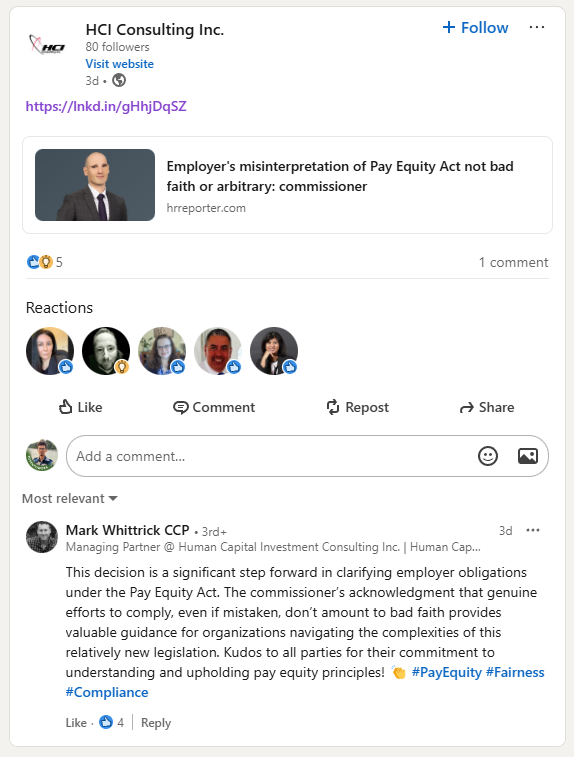‘This is the first time anybody’s had to comply with the act by establishing a pay equity committee’

“It isn’t bad faith or being capricious when simply misinterpreting legislation – bad faith requires a higher standard and a level of deliberateness, or at least willful blindness, as to one’s obligations under the legislation.”
So says Kyle Lambert, an employment lawyer at McMillan LLP in Toronto, after the federal Pay Equity Commissioner dismissed a complaint brought by the Public Service Alliance of Canada (PSAC) against the Bank of Canada regarding the composition of its pay equity committee. The commissioner determined that, while PSAC retains the right to select representatives on the committee for its bargaining units, the Bank didn’t act in bad faith by trying to limit the number of representatives.
“If you make a sincere effort to comply [with the act] and are found to have gotten it wrong, this decision suggests that you will be given an opportunity to right the ship without facing further sanction,” says Lambert. “Any incident of noncompliance is going to be evaluated on its own merits and its own facts, but it’s clear that mere noncompliance is not enough to prove bad faith.”
The Bank of Canada is the country’s central bank. It has about 2,300 employees, most of which aren’t members of a bargaining unit. However, PSAC represents 50 security officers in Ottawa and Montreal and was certified by the Canada Industrial Relations Board in 2011 to be the bargaining agent for information technology (IT) professionals employed by the Bank in Ottawa. The IT professionals didn’t ratify a collective agreement negotiated by PSAC in 2014, however, and they remained without one.
On July 18, 2023, the Bank contacted PSAC about the nomination of one representative and one alternate for its pay equity committee. According to the Bank, PSAC didn’t raise any concerns at the time about the number of representatives it had on the committee. However, in September, the union’s national office became involved and wanted to appoint four unionized employee representatives to the committee. The Bank balked, advising that it preferred PSAC to have one representative and one alternate, with four non-unionized employee representatives on the committee.
Pay equity committee
The Bank said that it was its responsibility to ensure that the statutory requirements for the committee were met. It could do this by establishing the composition of the committee, the Bank said, noting that one representative and one alternative would constitute 20 per cent of the committee’s members, while PSAC represented less than three per cent of the workforce.
In October 2023, PSAC filed a complaint with the Office of the Pay Equity Commissioner, alleging that the Bank acted in bad faith by unilaterally restricting the union’s participation in the pay equity committee to one regular member and one alternate. PSAC argued that, under the act, bargaining agents are entitled to select representatives for unionized employees without employer interference. The union sought an order to confirm its right to determine the number of representatives on the committee.
The Bank asserted that its decision to limit PSAC’s representation was proportionate to the union’s representation of less than three per cent of its workforce, maintaining that this would ensure the committee remained functional and representative. It argued that although the act was silent on the maximum number of representatives on a pay equity committee, that didn’t give PSAC free reign to select any number of representatives it wanted, as that could cause the committee to grow to such a size as to be non-functional. The Bank requested dismissal of the complaint or mediation to resolve the matter.
The Bank also argued that PSAC didn’t actually represent its Ottawa IT professionals, since the union hadn’t been involved with that bargaining unit since the collective agreement wasn’t ratified in 2014.
The commissioner found that PSAC was the certified bargaining agent for the Bank’s IT professionals, as established by the Canada Industrial Relations Board’s certification. Despite challenges to PSAC’s representation history, the commissioner ruled that the certification remained valid and conferred representational rights under the act.
Pay Equity Act
The commissioner noted that the act allows bargaining agents to select “at least one” representative for the committee but doesn’t impose a maximum. The commissioner explained that Parliament deliberately avoided setting limits on committee membership, leaving the selection process to workplace parties – and the act is human rights legislation that “must be interpreted broadly and liberally to advance its purpose.” Consequently, the Bank didn’t have the authority to cap PSAC’s representation, the commissioner said.
The decision in this regard may be concerning for employers, as there isn’t a clear answer on whether employers have the ability to place limits on the total number of committee members under any of the other subsections of s. 19 – such as the requirement that at least two-thirds of members be selected by employees, says Lambert.
“The commissioner’s decision seems to suggest that employees can pick however many people they want without the employer designating how many employee representatives there will be,” he says. “I don’t know immediately how large employers in particular are going to be able to conduct the necessary voting process through which employee-side nominees get chosen – there’s nothing in the decision that says that there’s no limit to the number of people employees can appoint under ss. 19(a) [two-thirds of members representing employees], but it can certainly be argued that the rationale used to interpret ss. 19(d) [at least one representative appointed by bargaining agent] would apply also to non-union employee representatives.”
Having employees vote on their representatives without identifying the number of people who will be on the committee or the number of slots for which they will vote is impractical, adds Lambert.
“It throws into question how you’re going to run the process altogether and seems to assume a level of understanding and knowledge of the act by employees that very likely doesn’t exist,” he says.
No bad faith by employer
PSAC alleged that the Bank’s actions were unilateral, arbitrary, and discriminatory, amounting to bad faith. However, the commissioner found that the Bank’s decisions were based on a genuine understanding of its obligations under the act. The Bank’s proportionality-based approach, aimed at maintaining a manageable committee size, was deemed reasonable given the act’s relative novelty and consequent lack of jurisprudence interpreting it – the act came into force in 2021 and the deadline for a pay equity plan was Sept. 3, 2024. There was no evidence of ill intent or arbitrary decision-making, said the commissioner in dismissing the bad faith and arbitrary conduct claims. PSAC’s claim of discrimination was also unsupported by substantive evidence, said the commissioner.
“It’s an important finding for employers in general, as what the commissioner is effectively saying is that if you make a reasonable effort to comply with the act but get it wrong, you’re not acting in bad faith,” says Lambert. “In other words, an error doesn’t amount to bad faith or arbitrariness – and notwithstanding the fact that the commissioner found that the Bank of Canada’s interpretation of s. 19 wasn’t correct, she didn’t conclude that there was any malfeasance there.”
The commissioner noted that the matter was complicated by the fact that the Bank and PSAC had opposing views of the employer’s role in the selection of pay equity committee members, which was understandable because it was the first time they were forming such a committee.
The commissioner dismissed PSAC’s complaint but affirmed the union’s right to select the number of representatives for its bargaining units on the pay equity committee.
“This is the first time anybody’s had to comply with the act by establishing a pay equity committee, and other than guidance on compliance released by the commissioner there isn’t any tool to interpret the act, other than the skills of your own counsel,” says Lambert. “Everybody was, and continues to be, interpreting the act in a bit of a vacuum, without the certainty that those interpreting a piece of legislation that’s been around for a number of years would otherwise have – and the commissioner’s decision reflects that.”

